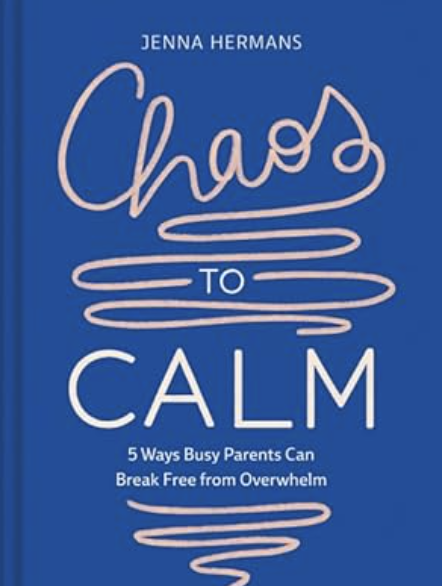Life is chaotic. It just is. There are daily demands on your time that can easily overwhelm you to the point that nothing gets done — and then, of course, you feel guilty about it. While you might not always be able to quell the chaos, you don’t have to let it rule your life, either. At least, that’s what Jenna Hermans, a certified high-performance coach and author of Chaos to Calm: 5 Ways Busy Parents Can Break Free from Overwhelm, believes. We spoke to Jenna about how to understand why chaos can control your life and how it can offer insight into your own needs, and how to bring your best self everywhere you go in life.
Jenna, everyone is stressed out. Is it really possible to mitigate chaos?
Chaos is an interpretation of what’s going on in your environment. What is chaotic for me might not be what is chaotic for my husband. For example, when I hear the kids running around and laughing, it actually calms me down because I think, “They’re all good.” For him, he hears loud sounds (even if it’s laughing and joyous), and it’s dysregulating.
I believe it’s possible to have a different relationship with the chaos. Whether the chaos is happening contextually or it’s something we feel inside, we need to try and understand it. It requires some self-awareness and the ability to dissect what’s really going on. Then, with that understanding, that can shift how you view and handle chaos.
It really is about awareness of your personal triggers and what makes you reactive.
How I define calm is a lead-in to those triggers. Calm, by my definition, is when your body and nervous system are regulated. When you’re not in flight or fight mode, you can be responsive and not reactive. It comes down to understating your own physiology and asking yourself, “Am I safe and am I okay?” It’s important to notice when you’re starting to get knee-jerky and how to get a calm response.
What would you recommend?
When it’s all too much, I would take a moment to find a quiet place and take some deep breaths — even if you think that you don’t have time for it. Your body and mind are connected, so when you take them out of the space, they will catch up to each other. Do something that lifts you up and changes your physical, emotional, and mental states. Then if you can, write down all the things that are going on. The stress response is because you have fear or anger, so when you can recognize that, you can identify the tasks and pressures that are staying in that mental load and get them off your plate.
Above all, have some self-compassion. Realize you’re handling a lot, and the pressure on parents (and moms especially) is so much. It’s the realization that the things we’re doing and thinking are all temporary. We’ve gotten through 100% of our hardest days. We survive and get through it all.
Oh, I love that. It can be hard to recognize that it’s not permanent when you’re in the throes of it. How do you keep that perspective?
You pare down to what the essentials are and prioritize it. Your energy will be lower, so have conversations with everyone and let them know the support you need for yourself, which will spill over and help your partner and family, too.
I feel like it’s not what we’ve been trained to do. We’re supposed to pack the schedules and do it all.
Society has set up parents in such a way that is not sustainable. It’s a radical idea to take things off your plate. But there are certain expectations that we put on ourselves, whether it’s from our families, society, or our cultures. Some are said out loud and others are intrinsic. If it’s not in service of your own mental health, then it’s okay to say no. If it doesn’t serve you, then why do it? You need to take care of yourself first.
If you and your partner perceive chaos in different ways, how can you find common ground?
It all starts with communication, self-awareness, and knowing what works for you and what doesn’t. That can change over time, so be open and honest with your partner about sharing your needs — and find out their own needs, too. Thing is, you need to keep it consistent; it’s not a one and done thing. So make it an open and ongoing conversation that might adapt over time.
My husband and I base every week where we talk about family life, business and other topics that might have shown up and need more intentionality. I have a working document that I write in throughout the week about important topics we need to talk about.
What is the biggest takeway you want readers to get from your book, Chaos to Calm?
You’re not alone. It doesn’t have to be this hard and you don’t have to go about it the way you’ve been doing it. You can achieve whatever it is that you want. You have to build the right foundation and infrastructure for yourself to make it happen.
What triggers you? There must be something.
Me asking over and over and over for my kids to do the same thing, over and over and over! Generally, it’s at the end of the day when I’m very tired and I want them to just go to bed. [laughs]
Here is an example: My 13-year-old is really into Rubik’s Cube, and he wanted to earn money so he could get it faster. He said, “Well, how about if I do everyone’s chores?” I said, “That sounds great for them, but how does that benefit me?” [laughs] So I said, “The only way that this benefits me is if I don’t have to give you any reminders at all. You just get it done. If I have to remind you, the deal is off.”
That’s funny. How did it work out?
For one whole week, he did everyone’s chores, and I didn’t need to remind him. It was beautiful! I asked him how it was getting everything done and not being reminded. He said, “Well, it was actually really easy, and I liked not being nagged.” I said, “What if you do this moving forward, with the one chore you have every week, and I don’t need to remind you?” Sadly, it didn’t stick!
Let’s talk about your business and how it ties into transforming chaos into calm.
Be Courageous is my husband and my business. We’re transformational engineers; we work mostly with fortune companies on big projects, and we also do smaller scale projects and private sector work as well. I do speaking engagements and workshops around calm in various contexts. We talk about calm and courage and infusing that into organizations at various levels, from C-Suite to middle managers and everyone in between because to make transformational changes, it can’t just be top down.
Chaos affects everyone, not just families.
Right. Everyone wants the same thing: to be collaborative, creative, work together, and problem solve. It’s not role modeled enough to know how to do it, though. It’s important for companies to know how to approach their employees to see how they can support them. It might be time management techniques, self-care, or having boundaries. What I love is by coaching these strategies to leaders, their employees will witness it, too. There will be a natural trickle-down effect where workers will feel that they’re being granted permission to do the same.
At its core, the book and these concepts are about showing up as your best self and taking the best you everywhere you go.




